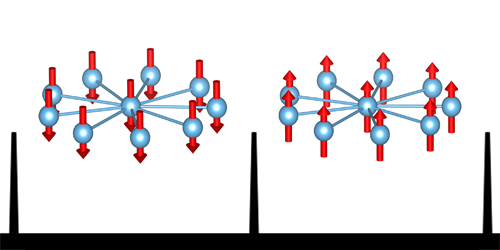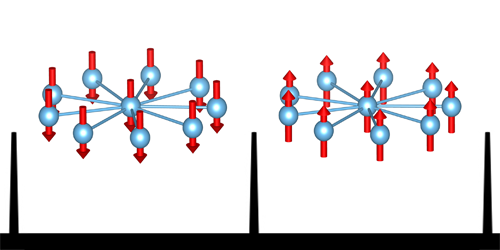Time Crystals Multiply
A time crystal is a collection of objects that spontaneously form a pattern in time, just as objects in a normal crystal spontaneously form a pattern in space. Theorists predicted time crystals in 2012 (see 15 October 2012 Viewpoint), and the first experimental demonstrations appeared in 2017 (see 18 January 2017 Viewpoint). Now, two separate groups have expanded the list of systems that can apparently host time crystals. Both experiments found discrete time-crystal signatures in spin systems controlled with NMR techniques. In the first case, the spins are inside a solid crystal, while in the second case, they are within star-shaped molecules in a liquid. The discoveries challenge current assumptions about what conditions are needed for time crystals to form.
Time crystals are different from other time-periodic systems (like pendulums and beating hearts) in that they don’t move to the rhythm set by their driving mechanism. Instead, they oscillate with a period that is an integer multiple of the driving period. In addition, according to most models, the periodic driving would overheat the crystal, and a discrete time crystal could only exist if the system is stabilized against heating by a disorder-induced phenomenon called many-body localization.
The first reported time crystals were in disordered systems. However, a group led by Sean Barrett from Yale University has now observed time-crystal signatures in an unexpected place: an ordered spatial crystal (ammonium dihydrogen phosphate). The team used radio frequency pulses to periodically rotate the spins of the phosphorous-31 nuclei inside the crystal. Despite the lack of disorder in the lattice structure, the spins exhibited time-crystal behavior, oscillating with a period twice that of the pulse sequence. To probe this phenomenon, the team developed new NMR techniques, which they detail in a companion paper.
In a separate NMR experiment, Ganesh Sreejith and colleagues from the Indian Institute of Science Education and Research in Pune identified time-crystal behavior in a liquid state, using molecules with a central spin surrounded by several satellite spins. The researchers exposed these star-shaped molecules to a sequence of spin-rotating radio pulses and found that the magnetization of the molecules oscillated at twice the pulse period. This periodicity emerged even without disorder in the system and remained stable against perturbations, such as changes in the spin-rotation angle.
This research is published in Physical Review Letters and Physical Review B.
–Michael Schirber
Michael Schirber is a Corresponding Editor for Physics based in Lyon, France.





